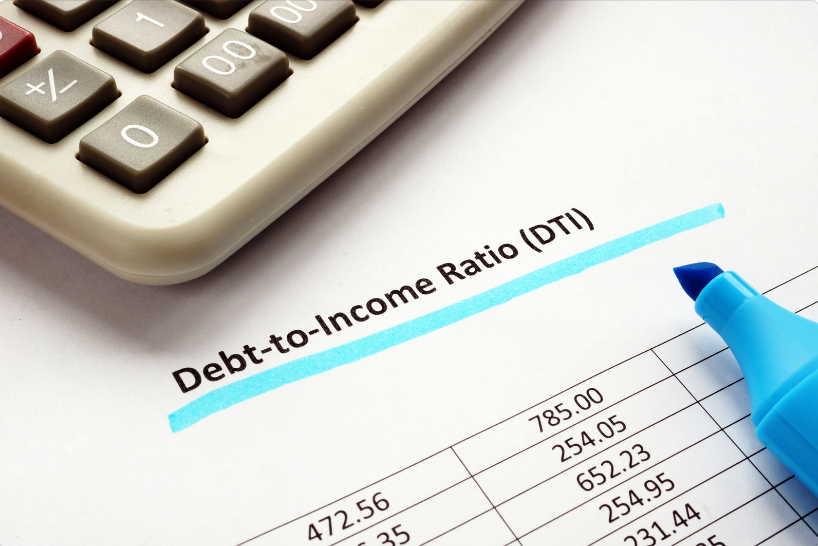Understanding Debt-to-Income Ratios and Mortgage Qualification

When you're planning to buy a home, it's important to understand how lenders evaluate your financial situation to determine your eligibility for a mortgage. One crucial factor they consider is your debt-to-income ratio (DTI).
What is a Debt-to-Income Ratio?
A debt-to-income ratio is a financial metric that compares your monthly debt payments to your gross monthly income. It helps lenders assess your ability to manage additional debt and make timely mortgage payments. It is normally expressed as a percentage. Mortgage brokers like Contemporary Mortgage Services, Inc., use this number to determine what the max monthly PITIA (Principal, Interest, Taxes, Insurance, and Association Dues) payment a borrower can qualify for and afford.
How is the Debt-to-Income Ratio Calculated?
To calculate your DTI, divide your total monthly debt obligations by your gross monthly income and multiply by 100 to get a percentage.
DTI Ratio = (Total Monthly Debt / Gross Monthly Income) x 100
Why is the Debt-to-Income Ratio Important for Mortgage Qualification?
Lenders use the debt-to-income ratio as a key indicator of your financial stability and your ability to handle mortgage payments. By analyzing your DTI, they can assess the level of risk associated with lending you money.
A lower DTI ratio generally indicates a lower risk for lenders, as it suggests that you have more income available to meet your financial obligations. A higher DTI ratio, on the other hand, indicates a higher level of debt relative to your income, which may raise concerns for lenders.
What is an Acceptable Debt-to-Income Ratio?
Acceptable DTI ratios vary depending on the type of mortgage and the lender's guidelines. In general, though, most lenders prefer a DTI ratio of 43% or lower.
- Front-End DTI Ratio: This measures your housing-related expenses (e.g., mortgage payments, property taxes, insurance) against your gross income. Ideally, your front-end DTI ratio should be 28% or lower.
- Back-End DTI Ratio: This includes all your monthly debt obligations, including housing expenses. For most lenders, the preferred back-end DTI ratio is around 43%.
(NOTE: Government loans, such as FHA and VA, typically allow for a much higher DTI ratio.)
How Can You Improve Your Debt-to-Income Ratio?
If your DTI ratio is higher than desired, there are several ways to improve it:
- Pay down existing debts: Reducing your outstanding debts can lower your DTI ratio and increase your chances of qualifying for a mortgage.
- Increase your income: Consider taking steps to increase your income, such as working overtime, taking a second job, or exploring new income streams.
- Avoid taking on new debts: Minimize new credit applications or large purchases that could increase your debt load.

Example Debt to Income Ratio Calculation:
Total Monthly Debt Payments = $580
Total Proposed Housing Payment = $2,000
Total Monthly Gross Income = $6,000
Calculations:
Front End Ratio: $2,000 / $6,000 = 0.3333 x 100 = 33.33%
Back End Ratio: $580 + $2,000 = $2,580 / $6,000 = 0.43 x 100 = 43.00%
In this above example, it would be best to keep the proposed total housing payment (PITIA) at or under the $2,000 a month amount, so that the back end qualifying ratio stays at or under 43%.
NOTE: You can still easily qualify for a mortgage with a DTI above 43%. FHA and VA typically will allow a much higher DTI than Conventional Loans. Conventional loans will also accept a DTI above 43%, and when it goes above certain %, it looks for other compensating factors.
In Conclusion
Understanding your debt-to-income ratio is essential when applying for a mortgage. Lenders use this ratio to assess your financial stability and determine your ability to handle mortgage payments. Aim for a DTI ratio below 43%, with front-end and back-end ratios below 28% and 36% respectively. To improve your DTI ratio, focus on paying down existing debts, increasing your income, and avoiding new debts. By managing your debt-to-income ratio effectively, you can enhance your chances of qualifying for a mortgage and achieving your dream of homeownership.
If you would like to run your own numbers and see where you stand, check out our free: Mortgage Pre-Qualification Calculator.
It's important to remember that these ratios are just basic guidelines. There are many additional factors that go in to qualifying someone for a mortgage.
At Contemporary Mortgage Services, Inc., we would be delighted to help to calculate your Debt-to-Income Ratios and utilize that info to pre-qualify you for a mortgage. With those ratios calculated, we can help determine the size of mortgage you qualify for and can comfortably afford. Call us: 407-834-3377.
